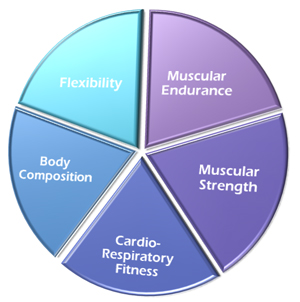5 Components of Health Related Physical Fitness
/
Did you know there are 5 key components of health related physical fitness? Do you know what they are? How do you stack up within all 5? Many of us over develop one area, neglecting others. Here they are listed in order of my opinion of importance.
Body Composition  - What percentage of fat mass is your body relative to your lean mass? Click on this link for a simple tool to gage how health your current body comp is. Human beings are fatter than ever before in the history of man. It is estimated that over 60% of Americans are overweight and or obese. Science has pinpointed a slew of chronic to lethal health problems associated with being overweight. Overweight being defined as having a Body Mass Index (BMI) of over 24. Click here to get yours now. However, this does not take into consideration the density of lean mass. Many athletes and exercise enthusiasts may be deemed over weight according to their BMI. A better yardstick would be calculating your body composition. Click on this link to gage where you are at or seek out your local personal trainer to conduct a body fat analysis.
- What percentage of fat mass is your body relative to your lean mass? Click on this link for a simple tool to gage how health your current body comp is. Human beings are fatter than ever before in the history of man. It is estimated that over 60% of Americans are overweight and or obese. Science has pinpointed a slew of chronic to lethal health problems associated with being overweight. Overweight being defined as having a Body Mass Index (BMI) of over 24. Click here to get yours now. However, this does not take into consideration the density of lean mass. Many athletes and exercise enthusiasts may be deemed over weight according to their BMI. A better yardstick would be calculating your body composition. Click on this link to gage where you are at or seek out your local personal trainer to conduct a body fat analysis.
Muscular Strength  - The ability to produce force. More importantly work = force x distance. If you cannot apply a given force, you may not even be able to move in extreme circumstances. In order to apply force and move, you need muscle mass. Your body develops that mass through resistance activities. Very important concepts to grasp as you age, your muscle mass decreases, which may one day limit your ability to get out of a chair! And back to body composition, the more lean mass you have (muscle), the less fat mass you should have in theory. So why not kill two birds with one stone, but developing your strength and body composition at once with some resistance activities you enjoy.
- The ability to produce force. More importantly work = force x distance. If you cannot apply a given force, you may not even be able to move in extreme circumstances. In order to apply force and move, you need muscle mass. Your body develops that mass through resistance activities. Very important concepts to grasp as you age, your muscle mass decreases, which may one day limit your ability to get out of a chair! And back to body composition, the more lean mass you have (muscle), the less fat mass you should have in theory. So why not kill two birds with one stone, but developing your strength and body composition at once with some resistance activities you enjoy.
Muscular Endurance  - Your body's ability to apply force repeatedly for a prolonged amount of time. Forget about getting out of your chair, can you do that repeatedly throughout the day, climb a flight of stairs, or walk for an extended period of time? Muscular endurance is very important for activities you would like to do beyond brief bursts of energy. If you want to stay active, maintain your muscular endurance.
- Your body's ability to apply force repeatedly for a prolonged amount of time. Forget about getting out of your chair, can you do that repeatedly throughout the day, climb a flight of stairs, or walk for an extended period of time? Muscular endurance is very important for activities you would like to do beyond brief bursts of energy. If you want to stay active, maintain your muscular endurance.
Cardiovascular Endurance  - Your heart and lung's ability to delivery oxygen and nutrient rich blood to your working muscles for muscular strength and endurance (anaerobic (without oxygen) activity) and cardio (aerobic (with oxygen) activity). If the heart and lungs are working optimally, forget about everything above. But dont spend too much time doing cardio. The American Heart Association recommends 30 cumulative minutes or more per day of aerobic activity to sustain sufficient heart and lung capacities. 60 min or more per day to manage weight! That 60 min would be better spent with 3-4 days of resistance training to develop your lean mass, shed fat mass, and boost your resting metabolism with metabolically active muscle!
- Your heart and lung's ability to delivery oxygen and nutrient rich blood to your working muscles for muscular strength and endurance (anaerobic (without oxygen) activity) and cardio (aerobic (with oxygen) activity). If the heart and lungs are working optimally, forget about everything above. But dont spend too much time doing cardio. The American Heart Association recommends 30 cumulative minutes or more per day of aerobic activity to sustain sufficient heart and lung capacities. 60 min or more per day to manage weight! That 60 min would be better spent with 3-4 days of resistance training to develop your lean mass, shed fat mass, and boost your resting metabolism with metabolically active muscle!
Flexibility  - last but certainly not least, and arguably of greater hierarchy than my list here. Really, the ability to move at all. The elasticity of your soft tissue, ie, muscles, tendons, and ligaments. A tight muscle muscle is second only to a weak muscle. A tight muscle is unable to apply a force across its entire surface area, through a full range of motion(ROM). While there are perils to being hyper-flexible, on the scheme of things, most people never get close to that. Though your joints require some degree of stability, many of us have less than optimal ROM around these joints. More often than not chronic pain or injury can be relieved through regular flexibility and muscular development training.
- last but certainly not least, and arguably of greater hierarchy than my list here. Really, the ability to move at all. The elasticity of your soft tissue, ie, muscles, tendons, and ligaments. A tight muscle muscle is second only to a weak muscle. A tight muscle is unable to apply a force across its entire surface area, through a full range of motion(ROM). While there are perils to being hyper-flexible, on the scheme of things, most people never get close to that. Though your joints require some degree of stability, many of us have less than optimal ROM around these joints. More often than not chronic pain or injury can be relieved through regular flexibility and muscular development training.
So what areas have you been neglecting? Perhaps its time to back off on the cardio or strength training or give some of these other important aspects some work. Cross training is a great way to stimulate the body, allow it to recover, and avoid injury, Ideally, all 5 of these components should be apart of your regular fitness regimen.

